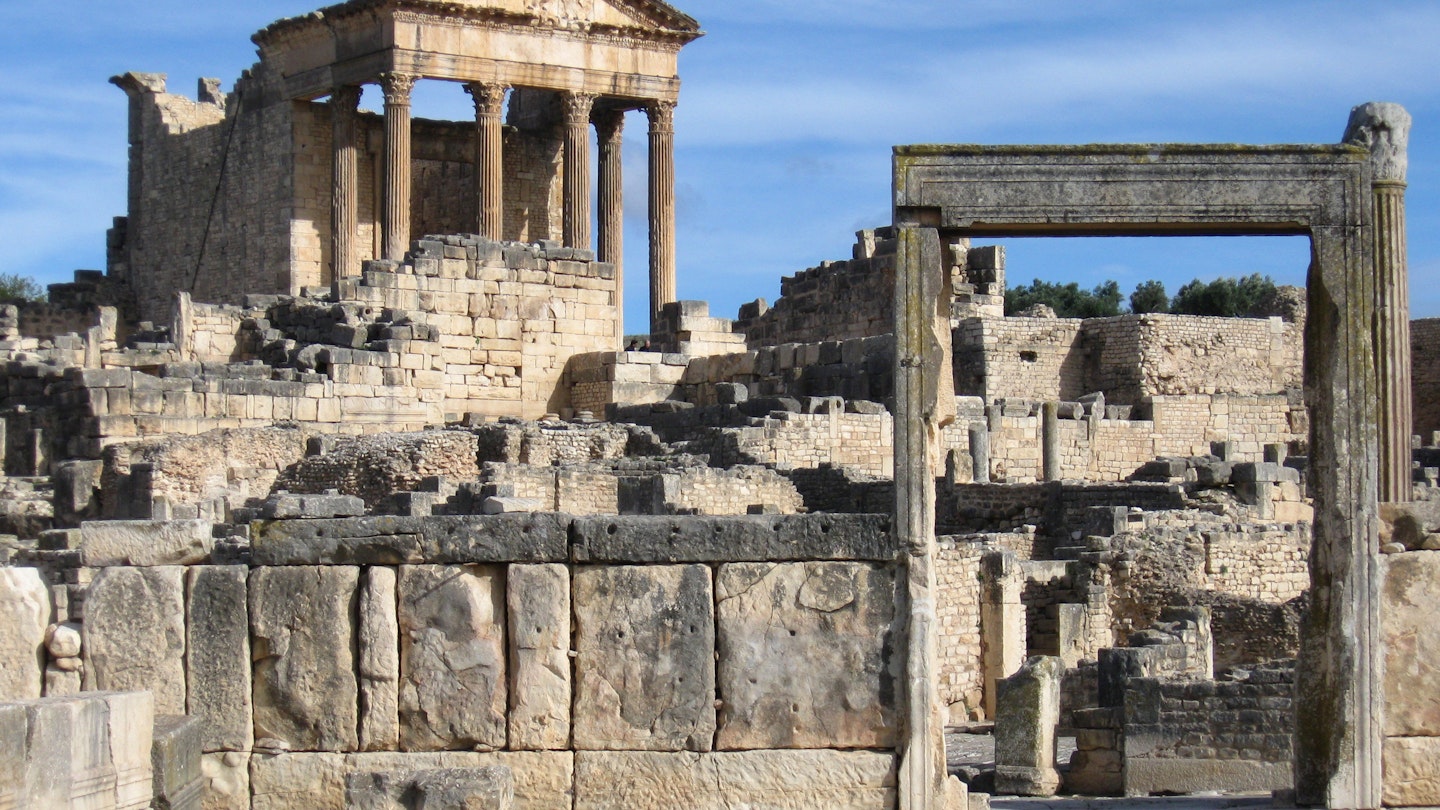Discovering the Ancient Roman Ruins of Tunisia
The ancient Romans need no introduction: at the height of their ambitious empire, they claimed some 5 million sq km of land, an impressive area about half the size of modern Europe. The Roman ruins in Italy are well-trodden, but those in Tunisia, and elsewhere on the southern side of the Mediterranean Sea, are equally lovely and much less visited. Moreover, they can be explored for a fraction of the price compared to their Italian counterparts.
Modern-day Tunisia was known as Africa to the ancient Romans, who named this remarkable landmass. Roman Africa served as the empire’s breadbasket, shipping olives and grains across the Mediterranean, thus thriving from the proceeds. Incredibly intact ruins of affluent ancient cities are scattered across Tunisia’s landscape, with many sites remaining unexcavated and unknown. Here are the best places to see the remnants of Rome in Tunisia.
El Jem

The colossal Unesco-listed colosseum at El Jem was the second largest in the Roman empire, only slightly smaller than the more famous version in Rome. Thought to have been constructed in the 3rd century AD, this amphitheatre could seat 35,000 spectators, far more than the town’s population. The southern side of the colosseum is the best preserved, allowing visitors to scramble up to the upper tiers of seating and imagine themselves cheering on gladiators. Two underground passageways, where ill-fated victims awaited, are also open for exploration, providing a glimpse into the dark thrill of Roman entertainment.
Dougga

Dougga stands out as one of the most captivating ancient Roman cities in Africa. Its remarkably complete streetscape invites you to step back in time to experience life as a wealthy Roman. The city boasted multiple bathhouses, temples dedicated to various gods, and a 3,500-seat theatre with panoramic countryside views.
Don’t miss the town’s most impressive feature, the Capitole, which was dedicated to the triad of Roman gods Jupiter, Juno, and Minerva. Six fluted columns extending 8m high still uphold the preserved pediment, illustrating the emperor Antoninus Pius being carried away by an eagle to the heavens. As the original settlement was the ancient Numidian town of Thugga, visitors will find a maze of winding streets, unique to the geometric planning of the Romans.
Sufetula

In the somewhat forlorn town of Sbeitla, the expansive ruins at the Roman site of Sufetula showcase an ancient city integrated within a modern context. This site hosts the best-preserved Roman forum in Tunisia, featuring three significant temples dedicated to the deities worshiped on Rome’s Capitoline Hill. Uniquely, small bridges connect these structures, providing access to a central temple that lacks its own entry steps.
The bountiful countryside, suitable for olive growing, allowed Sufetula to thrive long after other Roman towns succumbed. It became the regional capital under Byzantine rule, elevating its status in Christianity until its downfall by the Arabs. Unlike many other Roman sites, Sufetula has an extensive collection of churches, some still containing their mosaic-laden baptismal fonts.
Thuburbo Majus
Isolated yet conveniently located just an hour’s drive from Tunis, Thuburbo Majus attracts few visitors, making it an ideal destination for those seeking tranquility. In spring, the wildflowers create a picturesque nature reserve, alive with birdsong and the gentle rustle of grass.
Founded in the 2nd century AD, this city served as a colony for Roman war veterans who enhanced their legacy by funding public buildings and mosaics, ensuring their names would endure through time. The Palaestra of the Petronii is a remarkable representation of this tradition, constructed in AD 225, boasting Corinthian columns of attractive yellow-veined grey marble. Today, one row remains standing with scaffolding, still showcasing a Latin inscription. Additionally, some letters carved into the floor reveal a game used for teaching the alphabet.
Uthina
Despite being the closest site with an impressive collection of Roman ruins to Tunis, Uthina often falls under the radar for most travellers. While not much is known about the daily life here, it is one of the Roman empire’s earliest cities in North Africa. The restored Hadrian-era amphitheatre, capable of seating 16,000, is among the finest in the country. Recent funding has made the amphitheatre’s basement accessible, where felons and wild animals awaited their fates before the crowd.
At the top of the site sits the columned Capitole, which once housed a farmhouse belonging to a 20th-century French colonist—a structure only removed when Uthina officially became an archaeological site in 2008. The site also contains remnants of World War II history, as the large bathhouse was utilized for arms storage and bore damage from explosions.





